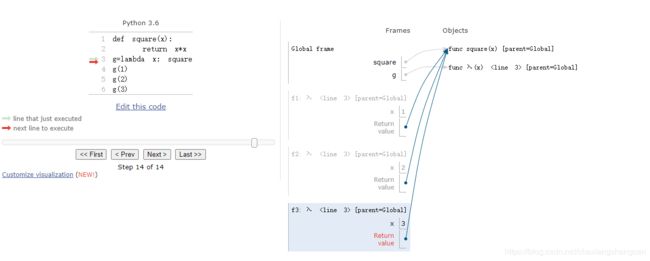HW02 lambda函数的一个问题
阐述一个有关lambda函数的问题
首先定义accumulate函数
def accumulate(combiner, base, n, term):
"""Return the result of combining the first n terms in a sequence and base.
The terms to be combined are term(1), term(2), ..., term(n). combiner is a
two-argument commutative, associative function.
>>> accumulate(add, 0, 5, identity) # 0 + 1 + 2 + 3 + 4 + 5
15
>>> accumulate(add, 11, 5, identity) # 11 + 1 + 2 + 3 + 4 + 5
26
>>> accumulate(add, 11, 0, identity) # 11
11
>>> accumulate(add, 11, 3, square) # 11 + 1^2 + 2^2 + 3^2
25
>>> accumulate(mul, 2, 3, square) # 2 * 1^2 * 2^2 * 3^2
72
>>> accumulate(lambda x, y: x + y + 1, 2, 3, square)
19 #(((2 + 1^2 + 1) + 2^2 + 1) + 3^2 + 1)
"""
i=1
while i<=n:
base=combiner(base,term(i))
i+=1
return base
Make Repeater问题
Implement a function make_repeater so that make_repeater(f, n)(x) returns f(f(…f(x)…)), where f is applied n times. That is, make_repeater(f, n) returns another function that can then be applied to another argument. For example, make_repeater(square, 3)(42) evaluates to square(square(square(42))). See if you can figure out a reasonable function to return for that case. You may use either loops or recursion in your implementation.
def make_repeater(f, n):
"""Return the function that computes the nth application of f.
>>> add_three = make_repeater(increment, 3)
>>> add_three(5)
8
>>> make_repeater(triple, 5)(1) # 3 * 3 * 3 * 3 * 3 * 1
243
>>> make_repeater(square, 2)(5) # square(square(5))
625
>>> make_repeater(square, 4)(5) # square(square(square(square(5))))
152587890625
>>> make_repeater(square, 0)(5) # Yes, it makes sense to apply the function zero times!
5
"""
"*** YOUR CODE HERE ***"
def compose1(f, g):
"""Return a function h, such that h(x) = f(g(x))."""
def h(x):
return f(g(x))
return h
我的解答:
if n==0:
return identity
g=f
while n>1:
f=compose1(f,g)
n-=1
return f
很自然的想法,用循环解决
补充问题:For an extra challenge, try defining make_repeater using compose1 and your accumulate function in a single one-line return statement.
答案:
def make_repeater2(f, n):
return accumulate(compose1, lambda x: x, n, lambda i: f)
对应表格:
| combiner | compose1 |
|---|---|
| base | lambda x: x |
| n | n |
| term | lambda i: f |
这里的重点是lambda i: f 这个隐式函数,lambda x: 2*x 表示输入参数x,输出2x,lambda i: f就表示输入参数i=1,2,3,4…恒输出f

这里可以看到 g=lambda x: square, g(1),g(2),g(3) 都是square函数。由此可见lambda函数在high-older function中有简化结构的作用,给人的感觉比较微妙,可参考curry(柯里化)的知识